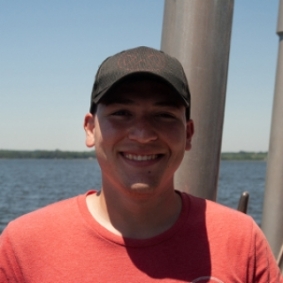Eight students will be presenting the summer work at the Ocean Sciences Meeting in March 2022!
Norberto Latorre Arzola, Universidad del Turabo
Class Year:
2018Mentor:
Judy O'Neil, Ph.D.Project Title:
Tracking Microbial Contaminants in Baltimore Harbor: Are Current Techniques Sufficient for Assessing Human Risk?
Abstract:
Coastal waterways receive fecal pollution from many sources each year in varying proportions around the world. Waters that have been polluted with storm water and urban runoff, sewage treatment plants, combined sewage overflows and sanitary sewer overflows can contain human pathogens. Methods that use fecal indicator bacteria (FIB), including E. coli and Enterococci, have traditionally been used to assess the human pathogen risk in waterways. However, these culture methods can be unreliable for several reasons: (1) FIB presence does not necessarily indicate pathogen presence, (2) they can appear from sources other than humans, and (3) sediments help FIB to persist and survive over the long term. Molecular methods are being developed that are more reliable in pointing to sources and pathogen presence. The World Harbour Project compares these two methods in twelve harbor systems around the world. Baltimore Harbor is one of the sites. We measured FIB and water quality parameters in eight sites that reflect more to less impacted in June and July and correlated them. Significantly higher FIB was present in a wet period sampling compared to a dry and there was also a gradient of FIB numbers from more to less impacted sites. This was also reflected in the relationship with salinity, with higher numbers of FIB in lower salinity (i.e. indicative of higher rainfall and also more impacted inner harbor sites). Additionally, a positive correlation of FIB numbers with total nitrogen was determined, but generally inverse correlations with all other water quality parameters. A longer time scale of sampling will be necessary to make more quantitative assessments. Samples are also being analyzed using next generation Illumina sequencing, and these molecular results will be analyzed across the World Harbour Project cities to help determine whether molecular techniques are more informative in predicting actual human pathogens rather than traditional FIB culturing methods and whether new methods could be implemented on a broader global scale to improve human health impacts associated with the fecal pollution problem worldwide.
Location:
Horn Point LaboratoryREU Update
Presented at ASLO 2019Presentations:
Latorre Arzola, N.*, M. Ross, B. Johnson, A. Volpitta, E. Schott, J. O'Neil. 2019. Tracking microbial contaminants in Baltimore Harbor: Are current techniques sufficient for assessing human risk?. ASLO Aquatic Sciences Meeting, San Juan, Puerto Rico.



